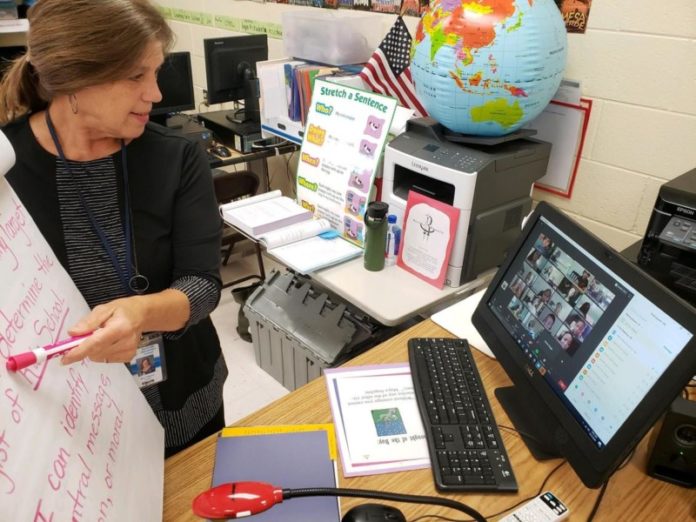
By KEITH RYAN CARTWRIGHT
Rutherford County Schools
There has been a lot of changes in the 38 years Bruce Haley has been teaching agriculture at Eagleville School.
One change he’s been slow to make is switching out his original, old school chalkboard for a modern dry erase whiteboard, but, that said, he won’t be denied when it comes to the challenge of learning how to use Microsoft Teams and Zoom video conferencing.
“Things I never thought I would do in my lifetime,” said Haley, who added, “I’m not backing away from any challenges.”
The challenge this time, of course, is districtwide as educators, students and parents face a school year unlike any other as it continues to deal with the fallout of the 2020 coronavirus pandemic. In July, the school board voted to open schools and follow strict protocols regarding social distancing and the wearing of masks, while also allowing parents and students to choose distance learning.
“We’ve overcome challenges before,” said Haley, who recalled the time Eagleville sustained extensive damage from a fire in June 1994 that left students, teachers and administrators “scattered in portables” for the entire 1994–95 school year. “But we made it through it and we’ll make it through this.
He added, “I’m always up for a good challenge.”
Several veteran educators — Mary Patterson, Grace Day, Angeline Gaddy, Sandy Stutts and Haley — share their insights regarding the school year ahead.
Patterson, who teaches third grade at Rockvale Elementary, prepared for the fall start to school by taking every professional development course related to distance learning.
She watched instructional videos like the ones offered by Pocketful of Primary and followed the Bitmoji Craze for Educators on Facebook.
“It’s a new world,” Patterson said, “and it’s exciting to be in it.”
Grace Day agreed.
“It is like starting over again,” said Day, who teaches third grade at Rock Springs Elementary. “I have a whole new learning curve with the tech things, all things technology.”
Some of these changes could impact traditional classrooms even after distance-learners return to the traditional classroom.
“If we do not come out of this having changed how we teach, then we missed it,” said Stutts, a math teacher at Smyrna High.
For instance, Gaddy, who in her 29th year of teaching math, has had past experience with online instruction. She earned an Education Specialist degree in Technology and Curricular Design, which focused on delivering online curriculum.
“I’m not new to distance learning,” said Gaddy, who earned an undergraduate degree in computer science, “but it’s very different when it is math and when it is high school students.”
The challenge online, according to Gaddy, is to keep students engaged when all they hear is a voice.
“I will be able to make connections so much better with the students that are in my classroom because there are so few of them,” Gaddy said, “but I’m going to have to work extra hard to connect with those distance learners.”
Haley agreed.
“I’m a visual learner and teacher,” Haley said, “because I like my students right here with me. … I could look at them when they walked in the door that morning and I could look at their eyes and I could look at the expression on their face and I could tell what’s been going on or what’s not been going on. I knew that maybe they needed to talk to me about something and I’d listen to them. It’s hard to do that when they’re away and they’re not looking at you. If you put a PowerPoint out there for them to look at, at home, you don’t have that one-on-one relationship.”
Together, teachers are figuring out what is best for the students.
In the meantime, Haley is thankful for the grace and mercy he’s received.
Prior to the first day, teachers at Rockvale Elementary practiced Zooming with each other and even went so far as to take turns hosting sessions so everyone could learn how to navigate the platform.
“The camaraderie among our faculty is heartwarming,” Patterson said. “Helping each other succeed in this new venture is a priority.”
It was the same for Day and her colleagues at Rock Springs Elementary.
She and her fellow third grade teachers got together and planned what virtual learning would look like for all third-graders at school. They wanted continuity from one virtual classroom to another. Two weeks in, at the end of each day, they still meet to discuss what worked and what did not work and, more importantly, what and how they can improve upon tomorrow’s lesson.
Much like their students, teachers are learning too.
And sometimes they are not learning from one another so much as they’re learning from students and parents.
“A couple of these young parents with lots of Zoom experience have even sent me private chat to direct me to the specific toolbar spot I was looking for,” said Patterson, whose heard similar stories from teachers throughout the district. “At 65, I am grateful when (parents) share their expertise.”
Patterson is thankful for the technology to connect with students who are at home.
And, truth be told, those students “are ecstatic to be with other kids.”
“At the end of a session, I always bring everyone into ‘The Brady Bunch’ style window to wrap up the lesson,” explained Patterson, referencing the famed opening sequence to the ABC sitcom of the early 1970s.
However, their daily goodbyes are more representative of “The Waltons” goodnight scenes during the nine seasons the weekly drama ran on CBS.
“My little one’s wave goodbye from their Zoom boxes and say, ‘See you tomorrow.’ It’s so sweet that they’re able to establish connections with other students this way,” Patterson concluded. “Socialization is so important at any age but especially for 8-year-olds.”
Please Join Our FREE Newsletter!















